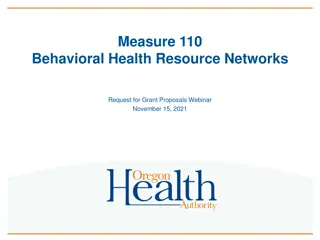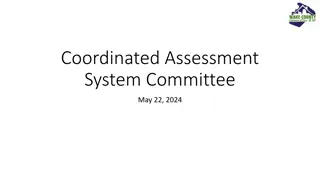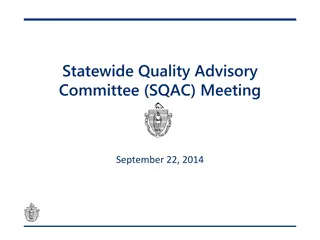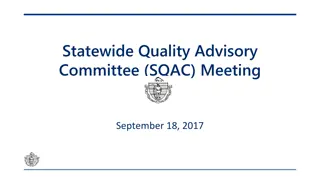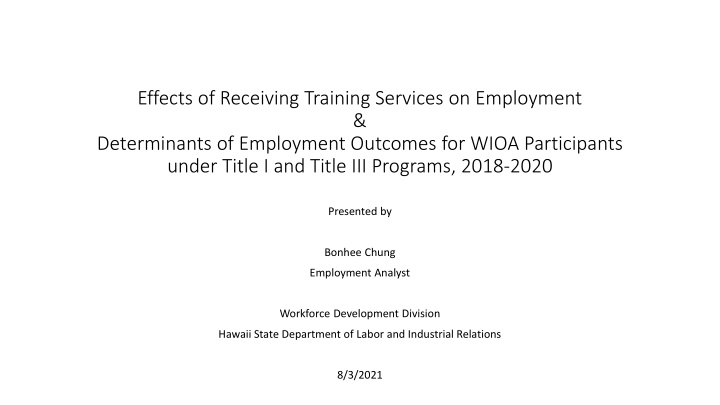
Determinants of Employment Outcomes for WIOA Participants 2018-2020
Explore the effects of receiving training services on employment outcomes and the determinants affecting WIOA participants from the Title I and Title III programs between 2018-2020. Key findings include demographic breakdowns, employment barriers, and statistical analysis of performance outcomes.
Download Presentation

Please find below an Image/Link to download the presentation.
The content on the website is provided AS IS for your information and personal use only. It may not be sold, licensed, or shared on other websites without obtaining consent from the author. If you encounter any issues during the download, it is possible that the publisher has removed the file from their server.
You are allowed to download the files provided on this website for personal or commercial use, subject to the condition that they are used lawfully. All files are the property of their respective owners.
The content on the website is provided AS IS for your information and personal use only. It may not be sold, licensed, or shared on other websites without obtaining consent from the author.
E N D
Presentation Transcript
Effects of Receiving Training Services on Employment & Determinants of Employment Outcomes for WIOA Participants under Title I and Title III Programs, 2018-2020 Presented by Bonhee Chung Employment Analyst Workforce Development Division Hawaii State Department of Labor and Industrial Relations 8/3/2021
Count Career Services n = 7346 Training Services n = 295 96% 4% Sex Male Female 3985 3204 54% 44% 97 33% 67% 198 Age 18-21 22-24 25-44 45-54 55-59 60+ 185 225 2911 1743 982 1300 3% 3% 40% 24% 13% 18% 20 22 7% 7% 52% 21% 8% 4% 154 63 25 11 Ethnicity/Race Characteristics of the Participants Hispanic 648 276 2287 358 2176 2793 1121 9% 4% 31% 5% 30% 38% 15% 39 11 13% 4% 44% 4% 35% 37% 23% Ameri Indian/Alaskan Asian Black 129 12 104 110 68 Program Title I (Adult and Dislocated Worker) Title III (Wagner Peyser) Native Hawaiian White Multi-race Other Demographics Veteran Disabled Unemployed 886 640 6548 12% 9% 89% 13 13 4% 4% 69% 203 Data Period 2018-2020 Education Level Secondary School Grad Some PS Edu PS Edu Cert AS/AA Degree BS/BA Degree Beyond BS/BA 2990 1619 333 598 1092 354 41% 22% 5% 8% 15% 5% 127 63 20 28 44 43% 21% 7% 9% 15% 2% Total Number of Participants 7,641 7 Employment Barriers Low Income Older Individual Ex-Offender Homeless/Runaway BDS/English Learn Single-parent Long-Term Unemployed Co-enrollment 908 2282 12% 31% 1% 4% 1% 3% 9% 7% 168 36 57% 12% 2% 2% 4% 13% 9% 38% 93 6 5 317 58 194 672 517 13 37 26 113
What are the Determinants of Performance Outcomes? estimate std.error statistic p.value (Intercept) 0.226942243 0.139639427 1.625201766 0.104119574 X1col_trnserv 0.99630965 0.144492114 6.895252777 5.37691E-12 X1col_female -0.012823172 0.049239701 -0.260423445 0.79453716 X1col_hispanic 0.07252293 0.082784813 0.876041485 0.381007481 X1col_asian 0.252110935 0.064650533 3.899595645 9.63535E-05 X1col_pacific 0.211574196 0.06760816 3.129418036 0.001751529 X1col_white -0.049310293 0.063422111 -0.777493717 0.43686754 X1col_multirace -0.103441028 0.094898022 -1.090023008 0.275703009 X1col_elig_vetstatus -0.066617049 0.09229126 -0.721813196 0.470409336 Logistic Regression Model X1col_disability -0.271936773 0.096544794 -2.816690185 0.004852131 X1col_employstatus -0.571981169 0.074989087 -7.627525471 2.39303E-14 X1col_secondarysch 0.1775613 0.114688507 1.548204832 0.121572989 X1col_postsecondarysch 0.108352605 0.12060225 0.898429377 0.368956681 X1col_postsecondarycert 0.428488471 0.154343864 2.776193748 0.005499942 X1col_aa 0.244121494 0.137083482 1.78082355 0.074941281 X1col_bachelor 0.250806769 0.126141607 1.98829534 0.046779036 X1col_advbachelor 0.070453153 0.155745147 0.452361784 0.651008373 X1col_lowincome -0.19413995 0.096509863 -2.011607341 0.044261345 X1col_olderind -0.286368737 0.052494768 -5.455186237 4.89215E-08 X1col_homeless 0.100960284 0.156279089 0.646025546 0.518262812 X1col_eng_lit_cultbar -0.863303509 0.273323541 -3.158540624 0.001585612 X1col_singlepar -0.208379067 0.157003769 -1.32722334 0.184434814 X1col_longtermunemployment 0.076942148 0.085115623 0.903972094 0.366010199 X1multiprog 0.118676987 0.088397873 1.342532154 0.179423512
Determinants of Positive Outcomes (Employment after 2nd Quarter) Participants who received training services are 2.7 times more likely to be employed than participants who received career services. Asian and Native Hawaiian are 1.3 times more likely to be employed than other minority groups (Hispanic, Black, American Indian, etc.). Participants who have postsecondary certificate or higher degrees are about 1.4 times more likely to be employed than participants who have less than a high school diploma.
Determinants of Negative Outcomes (Employment after 2nd Quarter) The odds of being employed is 24% lower if the participant is an individual with disability. The odds of being employed is 44% lower if the participant was unemployed at the time of entry. The odds of being employed is 18% lower if the participant was a low-income individual. The odds of being employed is 25% lower if the participant is an older individual. The odds of being employed is 58% lower if the participant is an English learner.
What is the effect of receiving training services on the employment after second quarter (Q2ER)? How do we measure it? Q2ER of those who could have received training services, but did not participate in training services Q2ER of Participants Average Treatment Effect on the Treated (Program Effect) (Training Service Recipients) Treatment Group Control Group (Counterfactual)
Who are the Treatment and Control Group in WIOA? Training Service Participants Treatment Group (n = 293) Total WIOA Participants 2018-2020 (N=7653) Career Service Participants Potential Control Group (n = 7360)
Propensity Score Matching Propensity Score Matching (Probability of Receiving Training Services based on Participant Characteristics) Propensity Score of Participants (Career Services) (1) 0.014 (2) 0.198 (3) 0.079 . . (7359) 0.327 (7360) 0.542 Propensity Score of Participants (Training Services) (1) 0.323 (2) 0.135 (3) 0.015 . . . (293) 0.721
Receive Training Services No Yes
Estimation Result Interpretation If a participant receives training services, his or her chance of getting a job is about 27 percentage points higher. Estimate... 0.26578 AI SE...... 0.039599 T-stat..... 6.7118 P-value...... 1.923e-11 Original number of observations.............. 7653 Original number of treated obs............... 293 Matched number of observations............... 293 Matched number of observations (unweighted). 424
Limitations The type, eligibility, and quality of training services differ widely under Title I (Adult and Dislocated Worker) and Title III (Wagner Peyser) programs. Therefore, the estimate may not represent any specific program effect per se, but the effect of receiving any training services. Non-Generalizable There could be other factors that affect the participation decision such as unemployment spell, motivation, innate ability, and (time) costs that are not easily observable. Not a perfect matching.
Further Research To obtain more accurate estimates, I need to dissect and divide participants into subgroups according to their characteristics (gender, education level, type of training services received, etc.) For more accurate propensity score and matching, I need to consider other important factors such as dates of enrollment, length of services, referrals or self- selection, funding availability, occupations before and after treatment, other pre- program conditions related to employment or unemployment, local economic conditions, etc.



